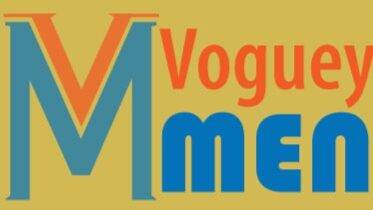Poland, the birthplace of vodka, guardian of the world’s largest castle, and exporter of nearly 70 percent of the world’s amber jewelry and craft, is also a land of vibrant sartorial expression. Its folk dresses and fashion accessories reveal a sophistication that is as diverse as it is unique, carrying centuries of tradition. From intricate jewelry to finely crafted garments, Polish fashion bridges the past with the present, often inspiring modern ethnic wear. Colors, patterns, and prints infused with Polish ingenuity make it truly distinctive. In this article, we’ll explore Poland’s traditional folk dresses, its iconic modern garments, and the quintessentially Polish fashion accessories that define its cultural identity.
Iconic Folk costumes and traditional garments from Poland
Polish folk dresses carry the heartbeat of regional identity, each ensemble alive with color, symbolism, and artisanal detail. In this section, we’ll explore five iconic regional costumes for men and women, beginning with the vibrant and world-renowned attire of the Łowicz region.
1. Lowicz Costume
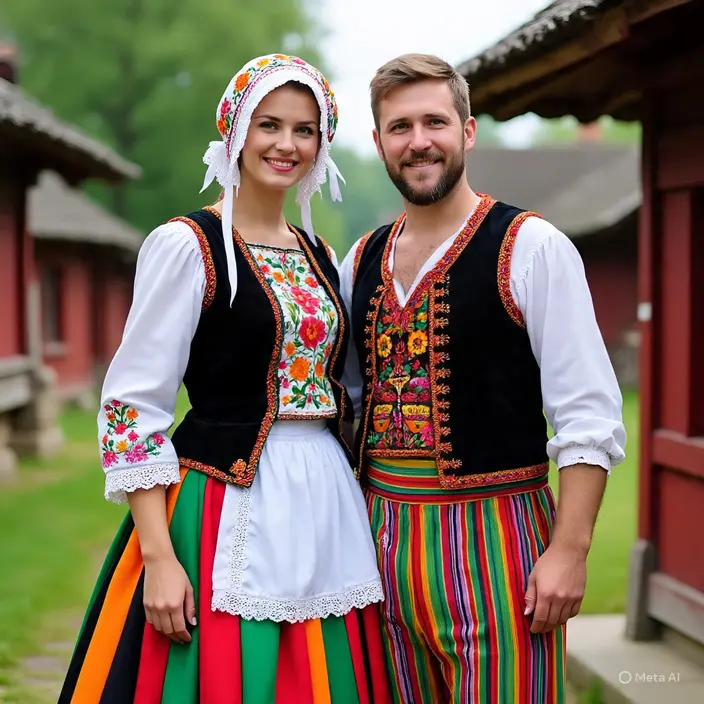
The Łowicz (Pronounced Woh-vich) costume hails from the Łowicz region in central Poland, known for its vibrant, multicolored stripes and intricate embroidery. This costume is a hallmark of Mazovian folk culture, often featured in festivals and celebrated for its connection to Polish paper cutouts (wycinanki).
Women’s Attire: Women wear a white blouse with vibrant floral embroidery on the sleeves and chest, paired with a voluminous skirt featuring bold vertical stripes in red, green, black, and orange. A black or colorful vest, richly embroidered, is layered over the blouse, and a white lace apron (zapaska) adds elegance. The headdress is a starched headscarf or bonnet adorned with floral motifs, often tied with ribbons, reflecting the region’s vivid aesthetic.
Men’s Attire Men’s attire includes distinctive striped trousers in matching vibrant colors, paired with a white shirt and a black or colorful vest with embroidery. A long, woolen coat, also embroidered, completes the outfit. A black felt hat with a decorative ribbon or band adds flair, emphasizing the Łowicz costume’s bold, festive character.
2. Kraków Region Dress (Krakowiak)
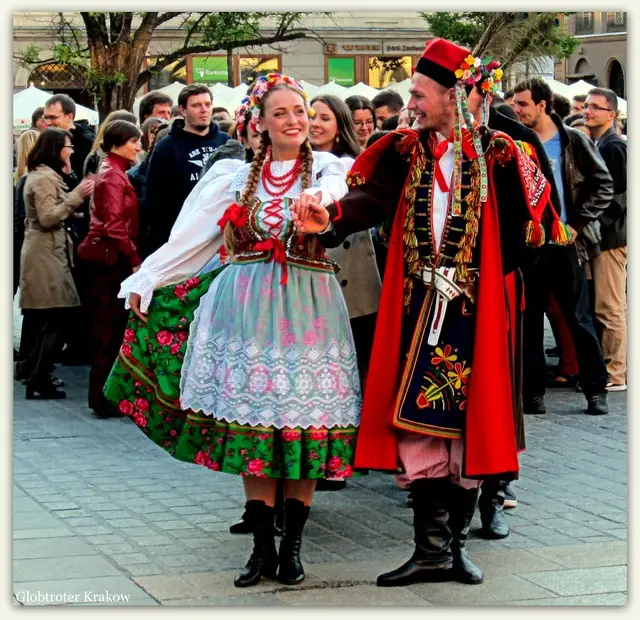
The Kraków costume, or Krakowiak, originates from the Kraków region in southern Poland. Renowned for its vivid colors and elaborate designs, it’s a symbol of Polish national identity, often worn during the Krakowiak dance and cultural events.
Women’s Attire: Women’s attire features a white blouse with intricate embroidery, paired with a red or blue skirt adorned with floral patterns. A korsetka, a laced corset with colorful embroidery, cinches the waist, while a white zapaska (apron) with lace adds charm. Unmarried women wear floral crowns or headscarves with ribbons, often decorated with flowers, symbolizing youth and beauty. Red coral bead necklaces enhance the festive look.
Men’s Attire: Men wear a white shirt (kaflik) with a red vest (kamizelka) and a wide, embroidered belt. A white woolen sukmana coat, decorated with colorful stitching, is a key element. The rogatywka, a four-cornered hat with peacock feathers or ribbons, completes the outfit, exuding elegance and tradition. Image Source
3. Góral (Highlander) Costume
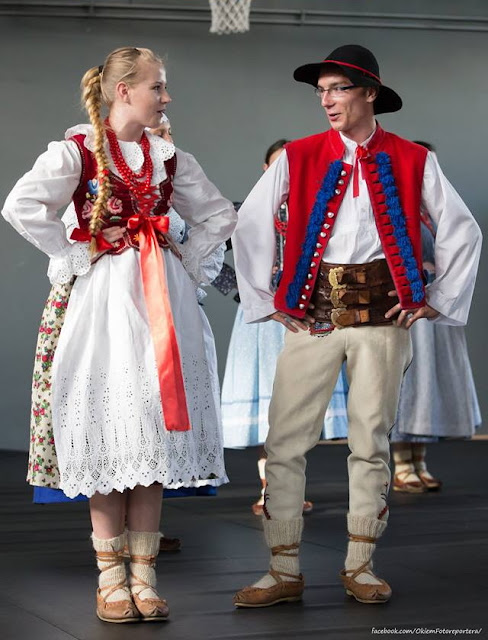
The Góral costume is worn by the highlanders of the Podhale region in the Tatra Mountains, southern Poland. Reflecting the rugged pastoral lifestyle, it’s celebrated for its woolen textures and intricate embroidery, often seen in festivals like the Zbójnicki dance.
Women’s Attire: Women wear a white blouse with delicate embroidery, paired with a floral skirt and a fitted corset adorned with beads or embroidery. A colorful chusta (shawl or headscarf), tied elaborately, adds vibrancy. Kierpce, handmade leather moccasins with decorative stitching, provide practicality and style. Accessories like coral beads or embroidered sashes enhance the outfit, blending femininity with highlander ruggedness.
Men’s Attire: Men’s attire includes tight white woolen trousers (portki) with parzenice, heart-shaped embroidery patterns. A white cucha jacket, richly embroidered in black, is paired with a white shirt. Kierpce moccasins and a black felt kapelusz hat, decorated with shells or feathers, complete the look, showcasing the Górale’s distinctive craftsmanship and cultural pride.
4. Bilgoraj Costume
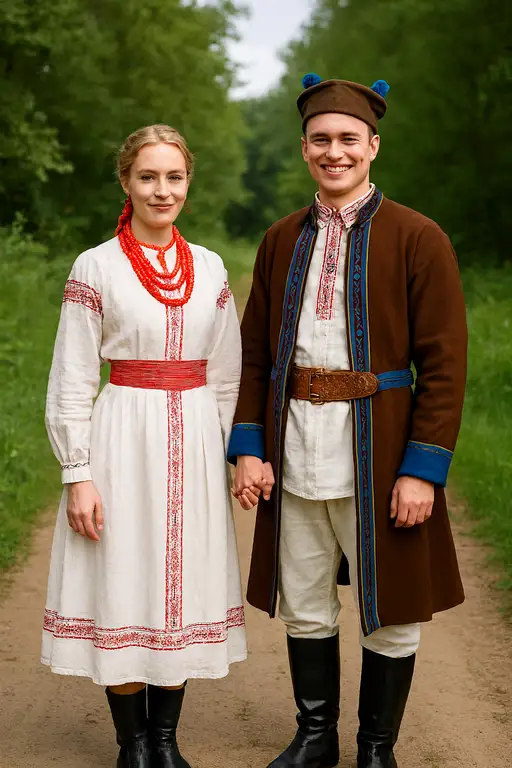
The Biłgoraj (Pronounced as Bee-wgo-rye) costume originates from the Biłgoraj region in southeastern Poland, part of the Lublin area. Known for its simplicity and rustic charm, it reflects the agricultural lifestyle of the region, with earthy tones and minimal ornamentation compared to other Polish costumes.
Women’s Attire: Women wear a long, white linen blouse with subtle embroidery, paired with a plain or striped skirt in muted colors like brown, red, or blue. A simple corset or vest, often unadorned, cinches the outfit. A white or cream zapaska (apron) with minimal lace adds modesty. Headscarves, plain or lightly embroidered, are tied simply, emphasizing practicality. Accessories like wooden beads or woven sashes complement the rustic aesthetic.
Men’s Attire: Men’s attire features a white linen shirt paired with plain trousers in earthy tones like brown or gray. A short, woolen vest or jacket, sometimes with subtle embroidery, adds warmth. A simple felt cap or rogatywka with minimal decoration completes the look, reflecting the Biłgoraj costume’s understated, functional design rooted in rural traditions.
5. Kashubian Costume
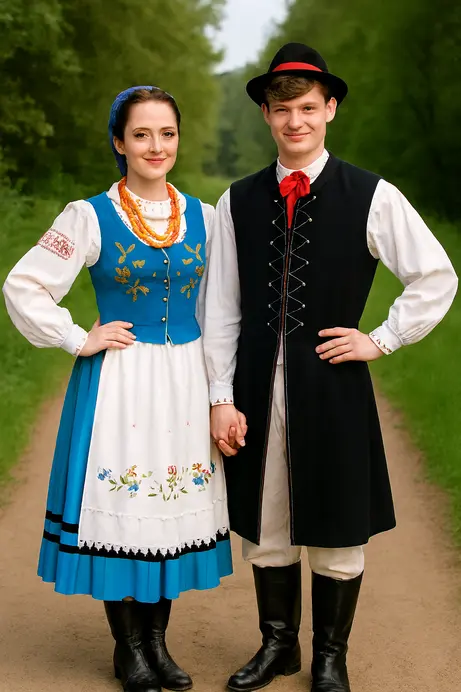
The Kashubian costume comes from the Kashubia region in northern Poland, near Gdańsk. Known for its delicate, gold-threaded embroidery and blue-gold color palette, it reflects the region’s unique cultural identity and maritime influences.
Women’s Attire: Women wear a blue or black dress with intricate floral embroidery in gold or white, often on the bodice and sleeves. A white or cream apron, adorned with lace or embroidery, adds elegance. The czôpka, a starched cap with gold-thread embroidery, is a distinctive headdress, often paired with a headscarf for married women. Accessories like amber necklaces or brooches highlight Kashubia’s connection to Baltic traditions.
Men’s Attire: Men’s attire includes a blue or black vest and coat with subtle floral embroidery, paired with a white shirt and dark trousers. A round cap, minimally decorated, serves as the headwear. The outfit emphasizes simplicity with refined details, reflecting Kashubian pride in craftsmanship and cultural heritage, often seen in regional festivals.
Garments that are Uniquely Polish
1. Sukmana
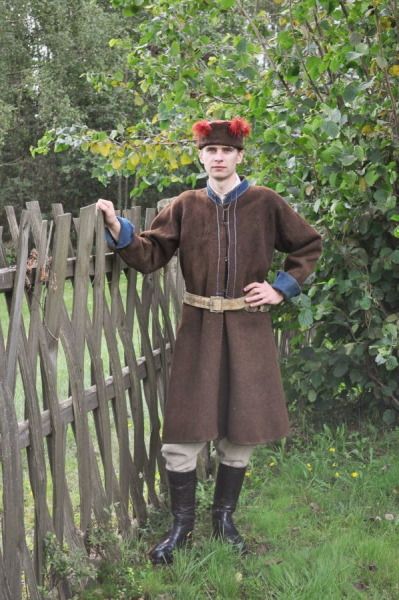
The sukmana is a long, loose-fitting Polish folk overcoat made of thick wool, often white or gray, providing warmth in rural settings. Its straight, knee-length cut features wide sleeves and decorative embroidery or colorful stitching, varying by region (e.g., Kraków, Łowicz). Fastened with buttons or a belt, it’s worn by men over traditional attire during festivals, ceremonies, or cold weather, symbolizing cultural heritage and practicality.
2. Polish Wz.93 Pantera Camouflage Jacket or Pants
The Wz.93 Pantera is a Polish military camouflage pattern used for jackets and pants, made from durable cotton-polyester blends. The disruptive, woodland-inspired design features green, brown, and black splotches. Jackets are tailored with multiple pockets and adjustable cuffs; pants have a rugged, straight cut. Used by the Polish Armed Forces since 1993, they’re designed for combat and training, offering camouflage, durability, and functionality in varied terrains.
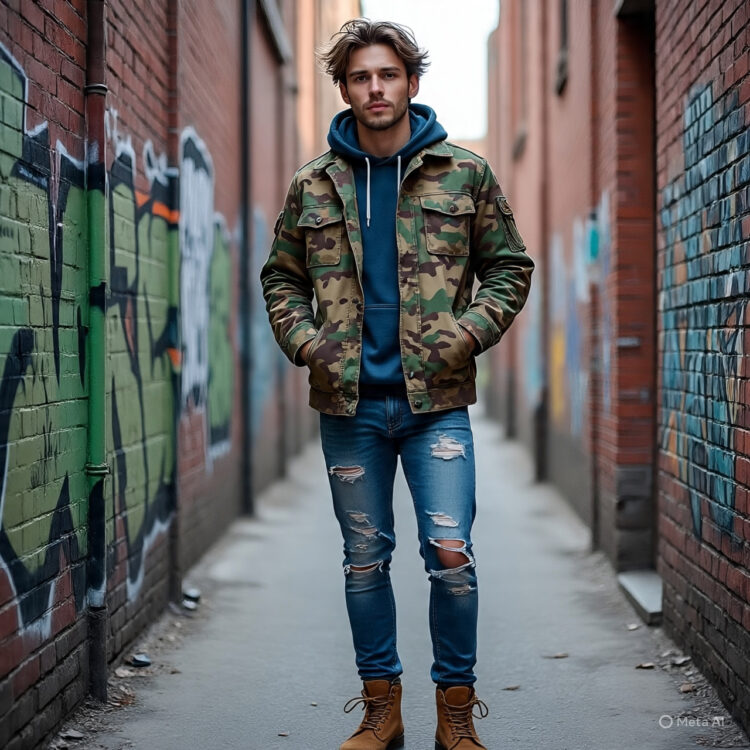
Fashion Accessories From Poland.
Polish traditional fashion is defined not only by garments but also by the striking accessories that complete each ensemble. From jewelry and caps to scarves and shoes, these add-ons hold cultural, symbolic, and aesthetic value. Read on to explore the most iconic Polish fashion accessories in detail
Polish Amber Jewelry
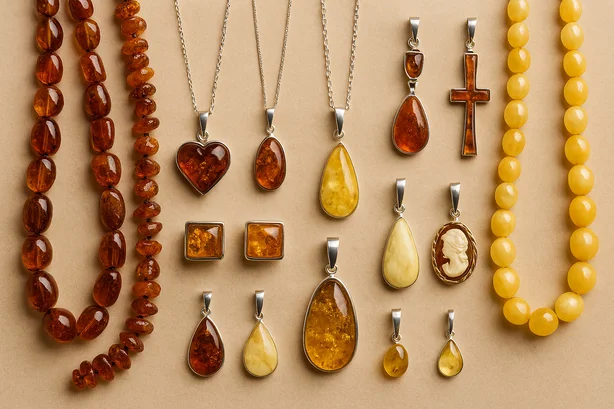
Amber jewelry is one of Poland’s most recognizable fashion treasures, sourced mainly from the Baltic coast. Crafted into necklaces, earrings, and rings, amber ranges from golden honey to deep cognac hues. Prized since ancient times for its beauty and supposed healing powers, it became a beloved adornment of Polish nobility and commoners alike. Today, Gdańsk remains the epicenter of amber craftsmanship, with designs balancing tradition and modern elegance. Amber jewelry remains a timeless Polish accessory, symbolizing heritage and natural artistry.
Krakuska Cap
The krakuska is a traditional four-cornered cap worn by Polish noblemen, students, and later soldiers. Typically made of wool or felt, it features a square top and was often decorated with feathers or rosettes. It became strongly associated with Kraków and the Polish legions of the 19th century, symbolizing patriotism and resistance during the partitions. Though no longer everyday wear, the krakuska remains a ceremonial and folk costume accessory, instantly recognizable as a marker of Polish identity and historical pride.
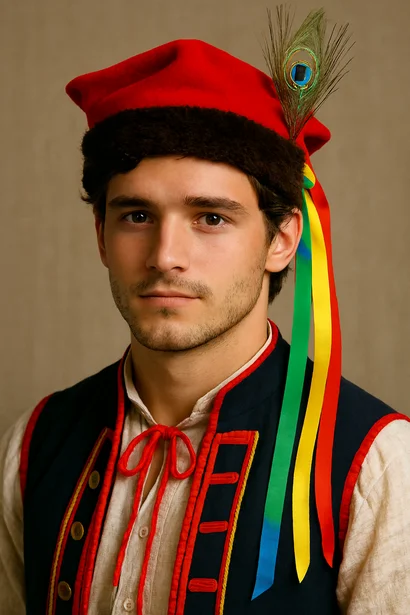
Czółko: The Ornate Forehead Crown of the Kurpie Woman
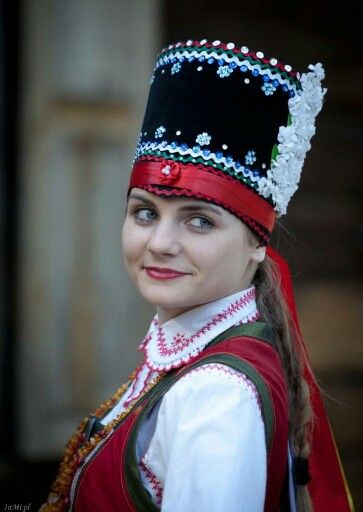
The czółko (pronounced “CHOO-wkoh“) is a traditional Kurpie headpiece worn by women during weddings, festivals, and folk celebrations. Structured from stiff fabric or cardboard, it rests across the forehead like a crown and is richly adorned with sequins, beads, ribbons, and artificial flowers. At its center sits the pępek—a circular ornament known as the “belly button”—which anchors the design and symbolizes wholeness and femininity. This headpiece reflects the artistry and identity of the Kurpie people, an ethnographic group from northeastern Poland’s Green and White Wilderness forests. Known for their independence, forest-based crafts, and vibrant costumes, Kurpie culture thrives in towns like Kadzidło and Myszyniec, where tradition and nature intertwine.
Gamerka Cap
The gamerką is a playful, four-pointed Highlander cap, each corner adorned with a pom-pom. Usually made from wool in bold colors like red or green, it is especially popular among children and dancers. Its whimsical shape and bright decoration make it stand out in folk ensembles, particularly in the mountain regions of southern Poland. The cap carries a cultural history tied to festive and leisure wear rather than formal dress. Still worn during Highlander performances, the gamerką remains a cheerful icon of folk tradition.
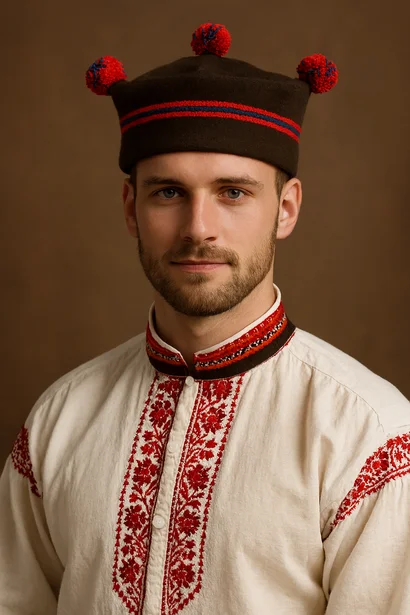
Kierpce
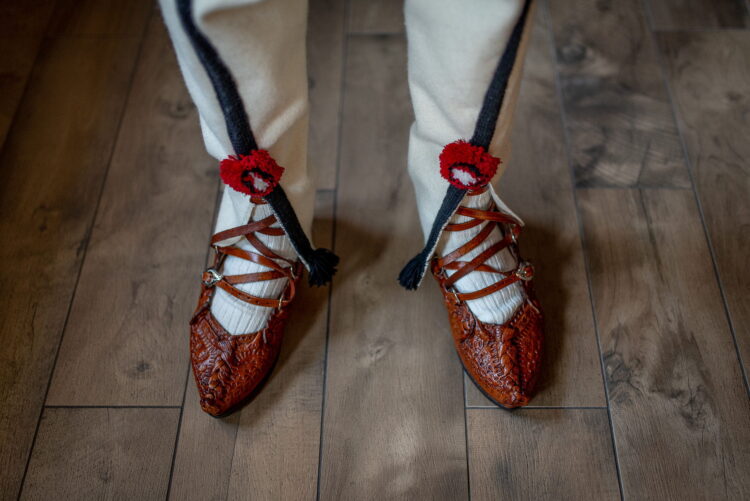
Kierpce (pronounced KYEHR-ptseh) are traditional leather shoes of the Polish Highlanders. Handmade from a single piece of tanned leather, they are gathered at the toes and tied around the ankle with straps. Their practical, lightweight structure made them ideal for shepherds and farmers in the rugged Tatra mountains. Worn with wool socks and regional dress, kierpce became a defining feature of Górale identity. Though largely replaced by modern footwear, they remain central in folk costumes and symbolize Poland’s mountain heritage. image source
Koraliki (Coral Bead Necklace)
Koraliki, strands of bright red coral beads, are a classic element of women’s folk dress in Poland. Traditionally worn with embroidered blouses and bodices, the necklaces were believed to protect against illness and misfortune. Coral was a valued import from the Mediterranean, making the jewelry both precious and prestigious, especially in rural communities. Passed down as family heirlooms, koraliki were often worn at weddings and festivals. Today, authentic coral is rarer, but the necklaces remain a powerful emblem of Polish femininity and tradition.
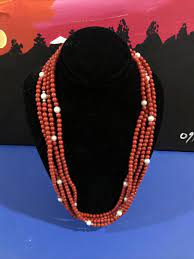
The Polish Highlander hat
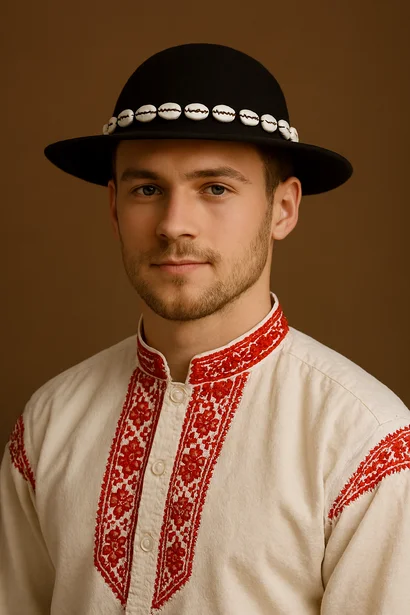
The Polish Highlander hat (Polish: kapelusz góralski) is one of the most iconic elements of the Górale folk costume from the Tatra Mountains in southern Poland. Traditionally made from black felted wool, the hat has a rounded crown and a moderately wide brim, both sturdy enough to withstand mountain weather. Its most distinctive feature is the decorative hatband, often adorned with white cowrie shells, sometimes paired with beads or metal studs. The shells, once imported luxury items, symbolized wealth and status among the Highlanders. This hat is worn by men as part of festive attire, especially during weddings, folk dances, and regional celebrations. Beyond its decorative role, it also served a practical purpose, providing shade in summer and some protection from rain or snow. Today, the Highlander hat endures as a cultural emblem of Podhale identity, instantly recognizable in Polish folklore and tourism.
Chusta Góralska (Tradional Gorale Scarf).
The Chusta Góralska (Polish Highlander scarf) is a vibrant and essential part of the Górale women’s traditional costume from the Tatra Mountains in southern Poland. Usually crafted from soft wool or cotton, it is square-shaped and generously sized, often folded diagonally into a triangle and draped over the shoulders. Its hallmark is the rich floral patterning—bold roses, peonies, or tulips in vivid reds, greens, and blues—set against a contrasting background, most commonly black, red, or white. The edges are finished with long, decorative fringes that sway gracefully with movement. Historically, the scarf provided warmth in the mountain climate, but it also became a marker of femininity and tradition, worn for church, festivals, weddings, and everyday life. Today, the chusta góralska is not only a folk costume staple but also a fashionable accessory, often reinterpreted in modern Polish design while preserving its folkloric charm.
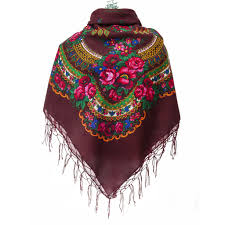
Polish fashion, with its rich blend of color, craftsmanship, and symbolism, remains a living testament to the nation’s history and spirit. Each accessory and garment is more than attire—it is an emblem of identity, pride, and resilience. Worn in festivals, weddings, and cultural celebrations, these pieces carry traditions across generations while continuing to inspire modern design. In celebrating them, Poland celebrates itself—its artistry, its diversity, and its enduring sense of belonging. Fashion, in this sense, is not just style but the fabric of Polish national pride.
Here’s an article about Fashion Accessories, traditional garments and modern sartorial contributions from France.
